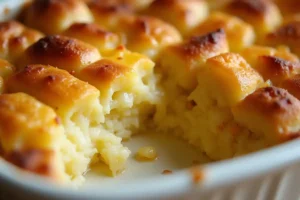Pineapple Casserole with Bread
Introduction to Pineapple Casserole with Bread
Why This Dish is a Southern Favorite
Pineapple casserole with bread is one of those delightful dishes that embodies Southern cooking—simple ingredients, bold flavors, and an innate sense of comfort. Rooted in traditions of combining fruits with baked goods, this dish showcases the creativity of home cooks in making something extraordinary from pantry staples.
From church potlucks to holiday dinners, this casserole has graced countless Southern tables, stealing the spotlight with its unique blend of juicy pineapple chunks, buttery bread, and often a hint of melted cheese. It’s no wonder it remains a favorite, even as food trends continue to evolve.
The Sweet and Savory Appeal of Pineapple Casserole
What makes pineapple casserole with bread stand out? It’s the marriage of sweet and savory that takes your taste buds on a roller coaster of flavors. The tangy sweetness of pineapple, paired with the hearty texture of bread and the richness of optional cheeses, creates an unforgettable culinary experience. It bridges the gap between dessert and side dish, making it versatile enough to pair with various main courses or stand on its own.
This flavor pairing isn’t just accidental; it’s deeply rooted in food science. The sweetness balances the saltiness, while the textures harmonize, making every bite feel complete. It’s a dish you can’t help but crave again and again!
History of Pineapple Casserole
Southern Roots of This Timeless Dish
Pineapple casserole has its roots firmly planted in the culinary traditions of the American South, where combining sweet and savory elements is a hallmark of regional cooking. Southern cooks are known for their creativity, turning simple ingredients into dishes that are both tasty and comforting. Pineapple casserole with bread likely started as a clever way to mix tropical fruits like pineapple—brought to American kitchens in the late 1800s—with common pantry items like bread, butter, and sugar.
This dish’s popularity grew as canned pineapple became more readily available in the early 20th century. Canned goods, often regarded as a modern convenience in their time, allowed home cooks to experiment with exotic flavors that might have otherwise been inaccessible. Pineapple’s naturally bright and sweet flavor made it an ideal choice for creating crowd-pleasing casseroles that balanced affordability, taste, and creativity.
How the Recipe Has Changed Over the Years
As the decades rolled on, the recipe for pineapple casserole began to evolve. Early versions focused primarily on sweet combinations, often using crackers or bread as a crust. Over time, savory components such as cheddar cheese were added, giving the dish its now-iconic sweet and savory identity. This shift reflected broader trends in Southern cuisine, which often embraced contrasts in flavor to create harmony on the palate.
By the mid-20th century, pineapple casserole had become a staple at family gatherings, church potlucks, and holiday feasts. Its versatility allowed for endless variations, from using different types of bread (such as Hawaiian rolls or French bread) to adding new layers of complexity, like spices or a sprinkle of cinnamon. Today, it remains a beloved classic, celebrated for its adaptability and rich history, proving that simple, heartfelt recipes truly stand the test of time.
Ingredients in Pineapple Casserole with Bread
Crafting the perfect pineapple casserole with bread begins with understanding its key ingredients. Each ingredient adds something special to the dish’s taste, texture, and charm. Whether you follow a classic recipe or add your own flair, these are the building blocks of this delicious casserole.
Pineapple – Fresh vs. Canned
Pineapple is the star of this dish, but the choice between fresh and canned pineapple often sparks debate.
Canned pineapple is the favorite for many recipes because it’s easy to use and reliably sweet. Available in chunks or crushed, it adds a soft, juicy texture that blends well with the other ingredients. The syrup in canned pineapple also adds extra moisture and flavor, making the casserole tender and delicious.
Fresh pineapple, on the other hand, has a brighter, slightly tangy flavor that can take the dish to the next level. However, it needs to be perfectly ripe to avoid a tart taste. Using fresh pineapple also requires more prep, like peeling and coring, which can make it less convenient when you’re short on time.
Bread Varieties That Work Best for the Recipe
The bread you choose significantly impacts the texture and overall heartiness of the casserole. Most recipes call for soft, buttery bread like brioche, challah, or even dinner rolls. These options absorb the pineapple’s juices and butter beautifully, creating a creamy, pudding-like base.
For a firmer texture, crusty breads like French bread or sourdough can also be used. They hold their structure better during baking, adding a slight chewiness to the dish. For those avoiding gluten, gluten-free bread substitutes work just as well with minor adjustments to the recipe’s moisture levels.
Key Components: Cheese, Sugar, and Butter
Cheese, sugar, and butter are the key players that take pineapple casserole with bread from simple to extraordinary. Cheddar cheese, with its sharp and salty taste, perfectly balances the pineapple’s sweetness, creating that signature sweet-and-savory blend. Sugar boosts the pineapple’s natural flavor, while butter adds richness and helps hold everything together.
These three ingredients work in harmony to make a casserole that’s not only packed with flavor but also indulgently comforting—a true Southern classic.
Nutritional Profile of Pineapple Casserole
Pineapple casserole with bread is more than just a flavorful dish; it also offers insight into the nutritional composition of a beloved Southern classic. While its richness may categorize it as a comfort food, understanding its nutritional profile can help you make informed decisions about portion sizes and ingredient swaps to suit your dietary needs.
Understanding the Calorie Content
The caloric content of pineapple casserole with bread varies depending on the ingredients and serving size. On average, one serving contains approximately 250–400 calories. This range depends largely on the type of bread used, the quantity of cheese, and whether additional sugar is added. Substituting low-calorie bread or reducing the amount of butter can help lower the calorie count without sacrificing much flavor.
For those seeking a lighter version, consider using whole-grain bread, cutting back on sugar, or replacing part of the butter with applesauce for natural sweetness.
Balancing Carbs, Proteins, and Fats in the Dish
- Carbohydrates: Pineapple casserole is naturally high in carbohydrates, with bread and pineapple making up the majority of its carb content. Expect around 30–40 grams of carbohydrates per serving, with much of this coming from natural fruit sugars and starches in the bread.
- Fats: Depending on the amount of butter and cheese used, the dish contains approximately 10–15 grams of fat per serving. Using reduced-fat cheese or plant-based butter can lower the fat content while maintaining richness.
- Proteins: The casserole offers a modest protein boost, with approximately 5–8 grams per serving, mainly derived from the cheese and bread.
This dish is a treat best enjoyed in moderation, but with thoughtful substitutions, it can fit into a variety of dietary preferences and lifestyles!
Step-by-Step Recipe
How to Make Pineapple Casserole with Bread
Creating pineapple casserole with bread at home is surprisingly simple. With a few pantry staples and some basic prep work, you can whip up this beloved dish in no time.
Preparation Steps
- Gather Ingredients:
You’ll need canned pineapple chunks (drained), bread (preferably soft like brioche or challah), shredded cheddar cheese, granulated sugar, and unsalted butter. For added flavor, cinnamon or nutmeg can be sprinkled in, but that’s optional. - Preheat the Oven:
Set your oven to 350°F (175°C) to ensure it’s ready when you are. Grease a casserole dish with butter or a non-stick spray. - Prepare the Bread Base:
Cut the bread into small cubes, about 1-inch in size. Spread the cubes evenly across the bottom of the greased casserole dish. - Mix Pineapple and Sugar:
In a mixing bowl, combine the drained pineapple chunks and granulated sugar. Stir until the sugar is dissolved and evenly coats the pineapple. - Layer the Ingredients:
Pour the pineapple mixture over the bread cubes, spreading it evenly. Sprinkle a generous amount of shredded cheddar cheese over the top.
Baking Instructions
- Prepare the Topping:
Melt the butter and drizzle it over the casserole. Optionally, sprinkle breadcrumbs or crushed crackers for an extra crispy topping. - Bake the Casserole:
Place the dish in the preheated oven and bake for 30–35 minutes, or until the cheese is melted and bubbly and the bread turns golden brown. - Cool Slightly Before Serving:
Remove the casserole from the oven and let it cool for about 5–10 minutes before serving. This allows the flavors to meld and makes it easier to slice.
Serving Suggestions
Pineapple casserole pairs beautifully with a variety of dishes. Serve it alongside roasted chicken, ham, or turkey for a complete meal. For festive occasions, it complements other Southern classics like green beans, mashed sweet potatoes, or a crisp garden salad.
You can also enjoy it as a standalone dish for breakfast or brunch, offering a delightful mix of sweet and savory to start your day. Don’t forget to garnish with fresh pineapple slices or a sprinkle of parsley for a decorative touch!
Variations of the Recipe
Popular Variations of Pineapple Casserole
The beauty of pineapple casserole with bread lies in its versatility. While the classic recipe is cherished for its balance of sweet and savory flavors, creative twists can make it even more exciting. From experimenting with cheeses to accommodating dietary preferences, this dish can be tailored to fit any occasion or need.
Adding Cheese to Enhance Savory Notes
Cheddar cheese is the traditional choice for pineapple casserole, adding a sharp, tangy element that complements the pineapple’s sweetness. However, other cheeses can work just as well, each lending a unique flavor profile:
- Mozzarella offers a milder, creamier texture, allowing the pineapple’s natural sweetness to shine.
- Parmesan adds a nutty, salty kick, enhancing the savory undertones.
- Gruyère introduces a touch of elegance with its rich, buttery flavor.
Experimenting with cheese combinations—like cheddar and mozzarella—can add depth to the dish, making it perfect for those who love bold, cheesy casseroles.
Incorporating Different Types of Bread
Bread is the backbone of this casserole, and choosing the right type can change its texture and flavor:
- Brioche or Hawaiian Rolls create a sweeter, softer base, amplifying the dessert-like quality of the dish.
- French Bread or Sourdough adds a chewy, hearty texture, balancing the casserole’s sweetness with a slightly tangy flavor.
- Cornbread gives a Southern twist, introducing a crumbly, buttery layer that blends beautifully with pineapple.
Each bread choice brings a different dimension, allowing you to tailor the dish to your personal preferences.
Gluten-Free and Vegan Options
For those with dietary restrictions, pineapple casserole can be easily adapted without losing its signature taste:
- Gluten-Free: Use gluten-free bread varieties or cornbread alternatives to make the dish suitable for those avoiding gluten. Ensure that the breadcrumbs or crackers used as topping are also gluten-free.
- Vegan: Substitute butter with plant-based margarine, cheese with vegan cheese shreds, and opt for a sugar-free or natural sweetener alternative. Additionally, fresh pineapple can be used to avoid processed ingredients found in some canned options.
These variations not only make the casserole more inclusive but also allow everyone to enjoy this delightful dish, no matter their dietary needs.
Pairing Suggestions
What to Serve with Pineapple Casserole
Pineapple casserole with bread is incredibly versatile, making it an excellent companion for a wide variety of meals. Its unique balance of sweet and savory flavors ensures it pairs beautifully with both rich, hearty main courses and lighter, refreshing side dishes.
Ideal Main Courses
The sweet, tangy notes of pineapple casserole are a natural complement to savory main courses, particularly proteins with bold flavors. Some of the best pairings include:
- Roasted or Grilled Chicken: The mild, juicy flavors of chicken are enhanced by the casserole’s sweetness.
- Honey-Glazed Ham: A holiday favorite, this pairing brings out the pineapple’s tropical zest while the casserole highlights the ham’s smokiness.
- Pork Loin or Tenderloin: Pineapple’s tangy profile cuts through the richness of pork, creating a perfect balance of flavors.
- Turkey: Whether it’s a Thanksgiving feast or a Sunday dinner, pineapple casserole adds a delightful twist to a traditional turkey meal.
Complementary Side Dishes
Round out your table with sides that complement the casserole’s flavors without overpowering them. Ideal options include:
- Green Bean Casserole or Steamed Vegetables: These lighter, earthy dishes provide a savory contrast to the casserole’s sweetness.
- Mashed Sweet Potatoes: Their creamy texture and natural sweetness pair beautifully with the tropical notes of pineapple.
- Coleslaw: A crisp, refreshing side that offers a textural contrast and balances the casserole’s richness.
- Garden Salad: Add freshness with greens, cucumbers, and a light vinaigrette to keep the meal balanced.
With these pairings, your pineapple casserole with bread will shine as a centerpiece or supporting star at any meal.
Tips and Tricks
Expert Tips for the Perfect Pineapple Casserole
Crafting a flawless pineapple casserole with bread requires more than just following a recipe. A few insider tips can take your dish from good to unforgettable. Whether it’s achieving the perfect texture or boosting flavors, these tricks will help you create a crowd-pleaser every time.
Ensuring the Right Consistency
The texture of your casserole is crucial to its success. To avoid a soggy or overly dry dish, follow these guidelines:
- Drain the Pineapple Thoroughly: If you’re using canned pineapple, ensure it’s well-drained. Too much liquid can make the bread overly mushy. If needed, pat the pineapple dry with a paper towel.
- Choose the Right Bread: Softer bread like brioche absorbs liquid evenly, creating a pudding-like consistency. For a firmer texture, opt for slightly stale bread or toast fresh bread cubes lightly before use.
- Don’t Overbake: Bake the casserole just until the top is golden brown and the cheese is melted. Overbaking can dry it out, diminishing its comforting texture.
Enhancing Flavor Profiles
Elevate the taste of your casserole with these simple yet impactful tips:
- Add a Dash of Spices: A pinch of cinnamon or nutmeg can enhance the pineapple’s sweetness and add warmth to the dish.
- Use High-Quality Cheese: Freshly grated sharp cheddar cheese offers a more robust flavor than pre-packaged options.
- Incorporate a Crispy Topping: Sprinkle crushed crackers, breadcrumbs, or even toasted nuts over the casserole before baking to add a delightful crunch.
With these expert tricks, your pineapple casserole with bread will always turn out rich, flavorful, and perfectly textured, leaving your guests asking for seconds!
Common Mistakes to Avoid
Avoiding Pitfalls in Making Pineapple Casserole
Even with a straightforward recipe, there are some common mistakes that can hinder the success of your pineapple casserole with bread. Thankfully, a few proactive steps can help you sidestep these issues and achieve perfect results every time.
Overcoming Common Issues
- Using Too Much Liquid: One of the most common mistakes is failing to properly drain the canned pineapple. Excess liquid can make the casserole soggy and unappetizing. Take the time to drain thoroughly, and if needed, use a paper towel to remove extra moisture.
- Not Preparing the Bread Correctly: Adding fresh, overly soft bread can result in a mushy texture. Slightly stale bread or lightly toasted bread cubes absorb liquid more evenly, helping maintain the dish’s structure.
- Overloading with Sugar: While sugar enhances the pineapple’s natural sweetness, overdoing it can overwhelm the dish. Stick to the recommended amount or adjust based on the sweetness of your pineapple.
Troubleshooting Undesirable Outcomes
- Dry Casserole: If your casserole turns out too dry, it could be due to overbaking or using bread that’s too firm. Cover the casserole loosely with foil during the last 10 minutes of baking to retain moisture.
- Bland Flavor: Lack of seasoning can leave your casserole tasting flat. Ensure you’re using flavorful cheese like sharp cheddar and consider adding a pinch of salt or spices like cinnamon to elevate the taste.
- Uneven Texture: Distribute ingredients evenly across the dish to ensure a balanced texture in every bite. Stirring the pineapple mixture before layering can help.
FAQs
Frequently Asked Questions about Pineapple Casserole with Bread
Can I use fresh pineapple instead of canned?
Yes, you can use fresh pineapple as a substitute for canned, but it requires some preparation. Peel, core, and cut the pineapple into small chunks. Fresh pineapple has a slightly tangier flavor, so you may need to adjust the sugar level to balance the taste.
What type of cheese works best in this casserole?
Sharp cheddar cheese is the most popular choice because its bold, tangy flavor contrasts beautifully with the pineapple’s sweetness. However, milder cheeses like mozzarella or richer options like Gruyère can also work, depending on your taste preferences.
How do I store leftovers?
To store leftovers, transfer the cooled casserole to an airtight container and refrigerate for up to 3 days. Reheat individual portions in the microwave or warm the entire dish in the oven at 325°F (160°C) until heated through.
Can this dish be made ahead of time?
Absolutely! Prepare the casserole up to the point of baking, then cover and refrigerate for up to 24 hours. When ready to serve, simply bake as directed, adding a few extra minutes to the baking time if it’s straight from the fridge.
Is it possible to make a healthier version of this casserole?
Yes! Swap out sugar for a natural sweetener like honey or maple syrup and use low-fat cheese to reduce calories. For the bread, opt for whole-grain or gluten-free options to suit your dietary needs.
What are some suitable bread substitutes?
If traditional bread isn’t available, try using crackers, cornbread, or even crushed pretzels. Gluten-free bread is an excellent option for those with dietary restrictions, and brioche or Hawaiian rolls can add extra sweetness for a dessert-like twist.



